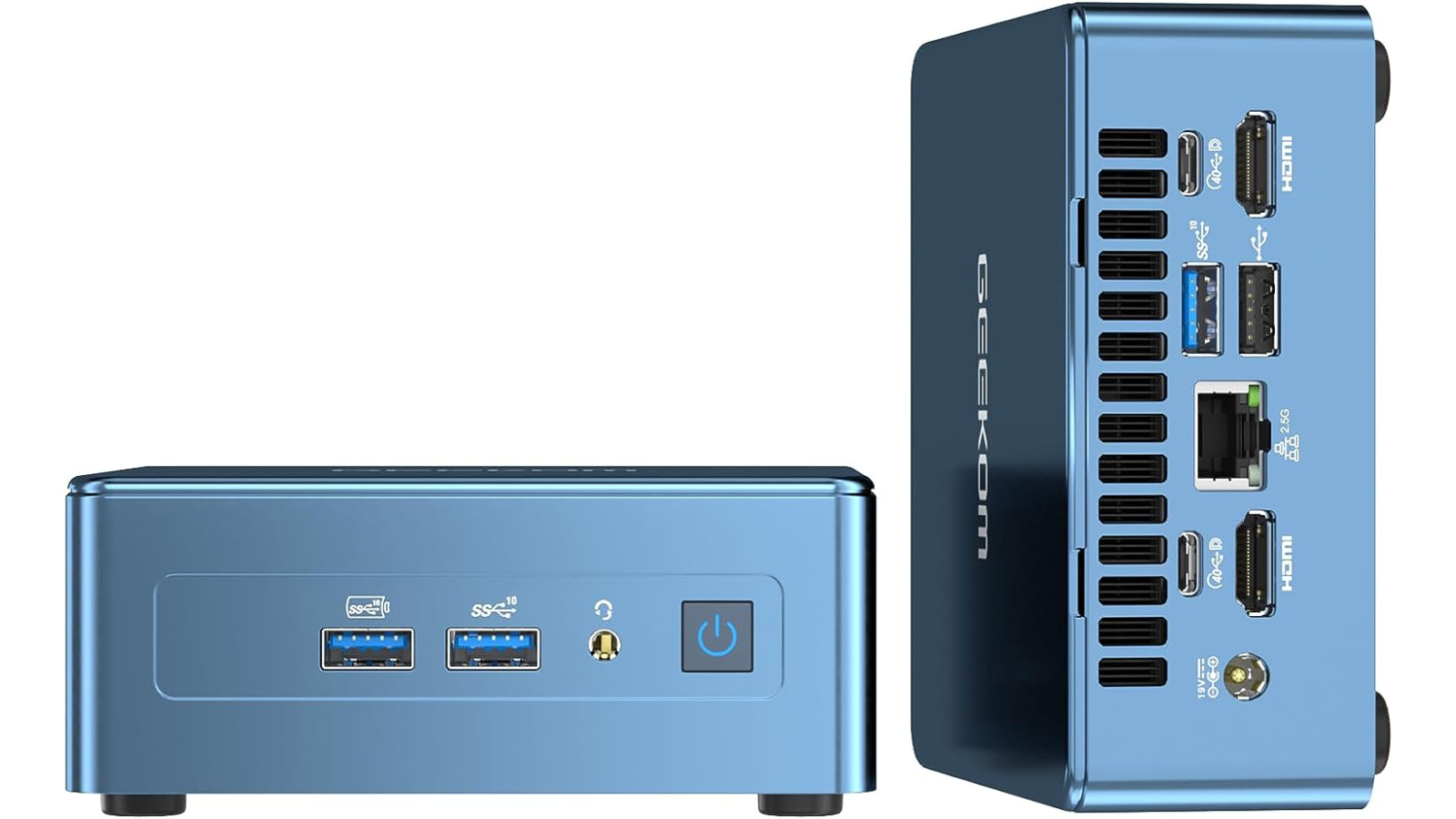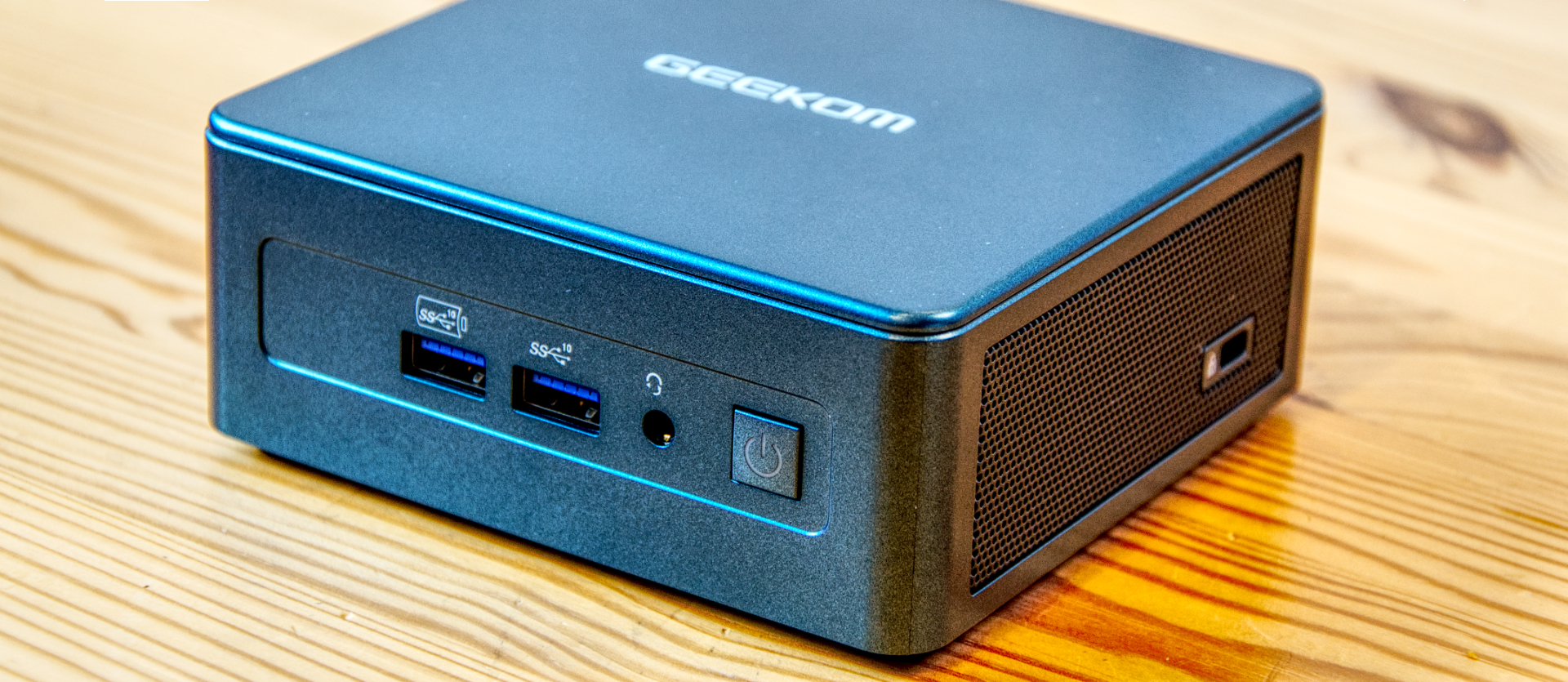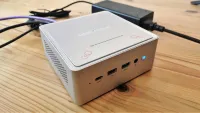TechRadar Verdict
That Geekom managed to squeeze a Core i9 processor inside an NUC is impressive. Sadly, this chip offers nothing significantly better than a Core i7 and is outperformed by a Ryzen 9 machine from the same brand.
Pros
- +
Core-i9 mobile CPU
- +
Easy internal access
- +
Upgrade potential
- +
Connectivity is excellent
Cons
- -
Expensive
- -
DDR4 memory
Why you can trust TechRadar
Geekom Mini IT13: 30-second review
Sporting a chip that never made it into the official Intel NUC product line, the Geekom Mini IT13 takes the concept this company created with the Mini IT11 to the next level.
Or that’s the logic we’re meant to apply. Unfortunately, besides the processor details and its support chipset, there is very little difference between this and the Mini IT12 or Mini IT11.
What colours this picture is that this is a mobile processor designed to operate on 45W of power in a battery-powered laptop. And, while the Mini IT13 isn’t battery-powered, the limitations on the power define what this machine can do, especially when it uses DDR4 memory.
That’s not to say this isn’t a powerful machine, and it can be upgraded with extra memory and storage beyond the purchased SKU, but it can’t escape the underlying truth that it isn’t a desktop platform and doesn’t perform at that level.
This machine is excellent in providing an exceptionally flexible tool that can serve files from external storage, be a hardware firewall or do any job that involves external devices connected by USB or Thunderbolt.
While it might seem implausible, this isn’t the best mini PC for speed, even with a Core i9 processor. Those looking for the ultimate small system solutions, from Geekom and others, should inquire under the section for AMD Ryzen 9 systems.
Geekom Mini IT13: Price and availability

- How much does it cost? Starting from $499/£449
- When is it out? Available now
- Where can you get it? You can get it directly from Geekom or from Amazon
Save $40 off the price of the Mini IT13 when you buy from Geekom direct. Use the code techradarpro40
If you prefer to use Amazon, use the code UL2F6QFD to get the same deal.
Buying directly from Geekom, four different SKUs are available in the UK for the Mini IT13. One uses the Intel I5-12500H with 16GB of RAM and 512GB of storage, and the middle order both use the i7-13700H with 32GB of RAM (1TB or 2TB). The one reviewed here uses the flagship i9-13900H processor with 32GB and 2TB of onboard NVMe storage.
Sign up to the TechRadar Pro newsletter to get all the top news, opinion, features and guidance your business needs to succeed!
The costs of these SKUs are £499, £599, £649 and £699 respectively.
For US customers, there are only three SKUs with the 2TB i7 model being omitted, and these cost $499, $649 and $789 for the i9 variant.
This hardware can also be bought through Amazon in the UK and the USA at roughly the same price.
Geekom is one of the first system builders to get a Mini PC of this specification into the market, but we expect more to follow soon.
- Value: 3 / 5
Geekom Mini IT13: Specifications
| CPU: | Intel Core i9-13900H (14 cores 20 threads) |
| GPU: | Intel Iris Xe (96 EU) |
| RAM: | 32GB LPDDR4X (expandable to 64GB) |
| Storage: | 2TB Lexar NM7A1 NVMe M.2 2280, unused M.2 2242 slot |
| Ports: | 3x USB 3.2 Gen2 Type-A, 1x USB 2.0, 2x USB 4.0 Type-C, 1x SD Card reader, 2x HDMI 2.0, 1x universal audio jack |
| Networking: | 2.5GbE LAN, WiFi 6E, Bluetooth 5.2 |
| OS: | Windows 11 Pro (pre-installed) |
| PSU: | 19V 6.32A |
| Dimensions: | 117*112*49.2mm |
Geekom Mini IT13: Design

- IT12 and IT11 reborn
- 2.5” SATA bay inside
- Big PSU
As its name implies, this NUC-sized system leverages the latest 13th generation Intel mobile processors, and in our review machine, this is the Raptor Lake cored Intel Core i9-13900H.
A theoretically powerful platform that Geekom somehow managed to fit inside this tiny box. However, because it was designed for a laptop, this chip is limited to a base power consumption of 45W and a Turbo mode of 115W.
If it used more power, it probably wouldn’t be possible to fit this platform in an NUC-sized enclosure without overheating issues.
Ergonomically, this isn’t substantially different from the Mini IT12 and Mini IT11 models that came before it.
It has the same two USB Type-A ports on the front along with the headphone jack and power button, and on the rear are the rest of the USB, HDMI out and the LAN port. The port numbers and types are identical to the previous models, including the side-mounted SD Card Reader.
Access to the inside is straightforward enough and involves the four screws that sit inside the four rubber feet. Once these are loose, the underside of the IT13 comes free and can be lifted all to the side to reveal the DDR4 memory slots and M.2 NVMe drive.
Going inside requires some precaution as the underside remains attached by a ribbon cable that connects a 2.5-inch SATA port on the reverse side of the lid.
That allows either a conventional HDD or SSD to be easily added. On the mainboard, there is also a spare M.2 2242 slot. It’s a shame this wasn’t a 2280-sized M.2 slot, but given the space limitations, some PCIe M.2 expansions exist and are appreciated.

Like its predecessors, the IT13 comes with a mounting plate for VESA holes on the rear of a monitor and a short HDMI cable to do a tidy job of that.
While it is possible to orientate it differently, the Geekom-approved method is to have the front face pointing upwards. That position allows easy access to the SD Card Reader slot on the left, and all the rear-connected cables hang directly down.
The power supply is a substantial block that uses a pin-barrel connector and is rated to 120W. There is sufficient cable for the PSU to be placed on the floor, irrespective of whether the IT13 is sitting on the desk or attached to a monitor.
In short, other than this enclosure's distinctive metallic teal appearance, there is nothing unusual here to see. And, without the special colour scheme, it could easily be mistaken for an earlier design.
- Design: 4 / 5
Geekom Mini IT13: Features
- 13h Gen Core i9
- USB 4.0/Thunderbolt
- PCIe 4.0 M.2
The headline feature of this machine is undoubtedly the Core i9 class processor, an i9-13900H.
But importantly, this is a mobile part and shouldn’t be confused with the Core i9 13900 desktop chips, some of which have a base power consumption of 150W.
Intel also makes another mobile part, the Core i9 13900HX, with a 55W base TPD and 157W turbo draw, but that 32-thread model isn’t the one used here.
What the i9-13900H has is six P-cores, all hyperthreading, and eight E-cores, giving a potential thread count of twenty. This core layout is the same as the Core i7-13700H; the only difference is the slightly faster base and turbo clocks on the i9. Both have the same 96 Execution Unit version of the Iris Xe GPU, 24MB Smart Cache, and power consumption limits.
As we’ll discuss in the performance section, this chip might be considered an i9 in name only, but the i9 products have been criticised as being more of a marketing exercise than a significant upgrade since inception.
This platform is undeniably useful because it is PCIe 4.0 capable, which is achieved with the Microprocessor being PCIe 5.0, whereas the chipset is PCIe 3.0. With 28 PCIe lanes to splash around on the I/O ports, this provides exceptional connectivity. Both USB 4.0 ports can shift up to 40Gbps, allowing for up to 8K monitors or external RAID boxes to be easily accessed.
The M.2 slots inside are PCIe Gen 4, enabling very fast NVMe drives to be connected, which can be twice the speed of the typical Gen 3 modules.
Overall, this is a great platform, but probably not worth the extra cost over the Core i7-13700H, with the same cores and PCIe lanes.

- Features: 4 / 5
Geekom Mini IT13: Performance
| Benchmark | Test | Score |
|---|---|---|
| 3DMark: | Wild Life: | 13,523 |
| Row 1 - Cell 0 | Fire Strike: | 5,369 |
| Row 2 - Cell 0 | Time Spy: | 1,935 |
| Cinebench R23: | Single-core: | 1,727 |
| Row 4 - Cell 0 | Multi-core: | 11,721 |
| Row 5 - Cell 0 | Ratio: | 6.79 |
| GeekBench 5: | Single-core: | 2,002 |
| Row 7 - Cell 0 | Multi-core: | 11,101 |
| Row 8 - Cell 0 | OpenCL: | 18,408 |
| CrystalDiskM.: | Sequential Read: | 4,857 MB/s |
| Row 10 - Cell 0 | Sequential Write: | 4,484 MB/s |
| PCMark 10: | Office Test: | 6,501 |
| WEI: | Score: | 8.3 |

- Effective CPU
- Not gaming fodder
- PCIe 3.0 NVMe isn’t ideal
Comparing this machine to other Mini PC designs, even other ones made by Geekom, is a slightly sobering experience. Because while this is a Core-i9, what that translates into for the benchmarks isn’t remarkable.
What was most striking here is that we recently covered the Geekom AS 6, a Ryzen 9 machine that, with a few small exceptions, beat this Core-i9 across the board.
The explanation is that the AMD Ryzen 9 has a better GPU and some other performance enhancements that enable it to outperform the i9 in most tasks.
What’s more surprising is that this hardware was also beaten by the Minisforum NBP7, a system that uses the Core i7-13700H. How does that work?
What it comes down to is that the Mini IT13 uses DDR4 memory, whereas the NBP7 uses DDR5, allowing much greater bandwidth that helps recycle the cache and also boosts the performance of the Iris Xe GPU that shares system memory.
In short, this is a fast Mini PC, but faster ones exist that use DDR5, and most of them cost less than this one.

- Performance: 4 / 5
Geekom Mini IT13: Verdict
In the cold light of day, the review specification hardware of the Mini IT13 isn’t worth the extra money, and the Core-i7 will provide a very similar experience and leave enough budget for a high-performance PCIe 4.0 NVMe drive or a 2TB SATA SSD.
Within the space and power constraints imposed by the NUC-sized mainboard and enclosure, the Mini IT13 does as well as expected. However, without DDR5 memory or a discrete GPU, throwing more cores at this problem delivers exponentially diminishing returns.
That Geekom is the only Mini PC maker offering this configuration at the time of writing hints that perhaps it wasn’t the best plan.
What’s good about this design is the exceptional connectivity, making it a highly flexible machine that can be useful in numerous ways. But you can get that connectivity with the lower specification versions and even the previous Mini IT12 model.
If you want a powerful Mini PC that can outperform this one, then the Geekom AS 6 is a better choice.
Should you buy a Geekom Mini IT13?
| Value | Expensive, considering it uses DDR4 RAM | 3 / 5 |
| Design | A derivative design that appears to be largely unchanged from the Mini IT12. | 4 / 5 |
| Features | An exceptional port selection that includes two USB 4.0 ports, and there are other expansion options inside. | 4 / 5 |
| Performance | Fast, but not the fastest, and slower than a Core i7 with DDR5 memory. | 4 / 5 |
| Total | Small and powerful NUC, but fails at being the top dog in a competitive space. | 4 / 5 |

Buy it if...
You must have Intel
Faster machines can be found using AMD technology, but some customers must have Intel-based hardware for historical reasons. While this is one of the highest-specification Intel Mini systems, you could save some money by upgrading this to a Core i7 version since the experience is largely the same.
Flexibility is critical
With room inside for some expansion and plenty of external USB ports, this machine can easily be repurposed should its purchase mission end. The inclusion of USB 4.0/Thunderbolt is critical, as it opens up many expansion possibilities.
Don't buy it if...
You want the fastest Mini PC
As quick as this system can be, it isn’t the fastest by some margin. Quicker alternatives either use Intel Core i7 processors or AMD Ryzen processors, both with DDR5 memory.
But a few systems also offer discrete GPUs, like the recently released Minisforum Neptune HX77G. If you want true power in a small form factor, all these are a better choice.
You don’t need fourteen cores
For general office work, a machine with fourteen cores that can process twenty threads is total overkill. While the Mini IT13 with a Core i9 processor is impressive, doing less demanding tasks will take the same amount of time on a cheaper i7 or i5 machine and save the budget for other useful items, like a Thunderbolt hub.
Also consider
Geekom AS 6
An alternative Geekom machine that is also very compact but powerful. Using the AMD Ryzen 9 6900HX (8 cores, 16 threads) and 32GB of DDR5 RAM, the performance on offer is a notch above the Mini IT13.
And it’s also cheaper by a few dollars.
Check out our Geekom AS 6 review
Minisforum Venus NPB7
The NPB7 is the flagship of the Venus series and features the incredible Intel Core i7-13700H (14 cores, 20 threads) mobile CPU and up to 32GB of DDR5 RAM. It can be bought barebones with only the processor installed, RAM and M.2 NVMe storage to be provided by the customer. If you want a high-quality Intel NUC with bags of performance and Thunderbolt baked in, the NPB7 is worth the investment.
Check out our Minisforum Venus NPB7 review
Apple Mac Mini (2023)
Recently revamped, the Mini now comes with either the M2 or M2 Pro chip, and it experienced a small price reduction from the M1 2020 model.
However, this machine can’t be upgraded, so you need to buy the model that you will ever need from the outset. For the M2 Pro version with only 16GB of RAM and 512GB of RAM, it will cost you $1,299. Or, twice the price of the AS 5 and more, and with other options, one can approach $5000 of spend. Not for the economically challenged.
Check out our Apple Mac Mini (2023) review
If this Mini PC doesn't fit your requirement, check out our selection of the Best Mini PCs
Mark is an expert on 3D printers, drones and phones. He also covers storage, including SSDs, NAS drives and portable hard drives. He started writing in 1986 and has contributed to MicroMart, PC Format, 3D World, among others.




